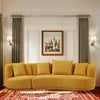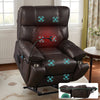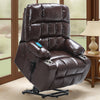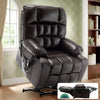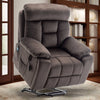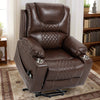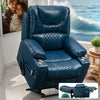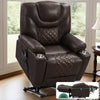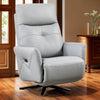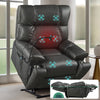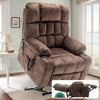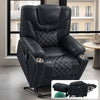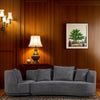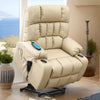Introduction to Recliner Chairs for the Elderly
Understanding the Need for Reclining Chairs in Elderly Care
As people age, their mobility and flexibility often decline, leading to a greater need for comfort and support when seated. Reclining chairs for the elderly are specifically designed to meet these requirements by providing an easily adjustable seat that allows the user to sit, recline, and stand up with minimal strain. The ability to recline can reduce pressure on the spine and joints, which is especially beneficial for those with arthritis, back pain, or mobility issues. These chairs often come with additional features like massage or heat that can further enhance comfort and improve circulation, key considerations in elderly care. Recliner chairs not only improve the quality of life for senior citizens by increasing independence but also contribute to their overall health and well-being.
Key Features to Look for in an Elderly Recliner Chair
Size and Space Requirements
When selecting a recliner chair for the elderly, it's crucial to consider the chair's size and the space available in your home. The chair should be large enough to provide ample comfort without overpowering the room. For restricted spaces, choose a compact model that still offers the necessary reclining features. Measure the area where you'll place the chair, ensuring there's enough clearance for it to recline fully without bumping into other furniture. Additionally, factor in space for mobility devices, such as walkers or wheelchairs, to allow easy access. A proper fit ensures the chair enhances living quality without becoming an obstacle.
Recline Mechanics and Adjustability
Choosing the right recliner chair for an elderly person requires special attention to the recline mechanics and adjustability. It is important to select a chair that offers various degrees of recline. This ensures comfort, whether the user wants to sit up to read or lie back to rest. Look for models that provide smooth, easy-to-use controls so adjusting the chair's position is effortless, even for someone with reduced strength or dexterity. Additionally, infinite position recliners can be very beneficial as they allow the feet to be elevated above the heart, promoting better circulation. Some chairs even come with remote controls or simple touch buttons for ultimate ease of use. Remember that the mechanism should also be quiet and gentle to not disturb or startle the user during adjustments. Pay close attention to these aspects to enhance the overall comfort and independence of the elderly individual using the recliner.
Durability and Build Quality
Durability and build quality are top considerations when selecting a recliner chair for the elderly. You want a chair that can withstand daily use without wearing down or breaking. Look for a frame constructed from solid hardwood or metal that ensures longevity and stability. Check the chair's weight capacity to ensure it can accommodate the intended user. Durable materials like high-quality leather or specialized fabrics can offer both comfort and longevity, and are better suited for long-term use. Pay attention to the manufacturer's reputation for quality, and read reviews to gauge the durability of the chair you're interested in. This investment in a sturdy and well-built recliner will provide safety, reliability, and peace of mind for both the user and their caregivers.
Comfort and Ergonomic Design
The cornerstone of any quality elderly reclainer chair is its comfort and ergonomic design. When looking for a recliner chair for an older user, prioritize options that offer ample cushioning and support. It's crucial to select a chair with a backrest that conforms to the natural curve of the spine, helping to alleviate pressure points and prevent discomfort. An ergonomically designed chair should also include adjustable features like lumbar support, which can be tailored to the individual's needs for additional comfort. Look for chairs with plush armrests and a seat with just the right firmness to ensure ample support without compromising on comfort. It's also beneficial to have a footrest that easily extends to allow the legs to rest and improve circulation, which can be particularly important for those with mobility issues. Always consider the user's body size and shape when assessing potential chairs to ensure a perfect ergonomic fit. Additionally, the fabric and materials should be soft to the touch while also being durable and easy to clean.
The Importance of Functionality in Recliner Chairs
Extra Functionalities That Benefit the Elderly
When selecting a recliner chair for an elderly individual, added features can dramatically enhance comfort and convenience. Look for chairs that offer built-in heating and massage functions, which can help to soothe aches and improve circulation. Additionally, easy-to-reach side pockets or compartments for storing personal items like reading glasses or remote controls are practical and reduce the risk of overreaching and falling. Chairs with a simple control system are also beneficial, especially for those who may struggle with complex mechanisms. Finally, consider models with a battery backup system, ensuring the chair can be operated even during a power outage, providing peace of mind and continuous comfort.
Choosing Between Power and Manual Recliners
When selecting a recliner chair for the elderly, the choice between power and manual options is crucial. Power recliners typically offer smooth, effortless reclining at the touch of a button, making them ideal for individuals with limited mobility or strength. They often include extra features such as lift assistance, which can be especially beneficial for those who have difficulty standing up from a seated position. Conversely, manual recliners require more physical effort to operate, as they rely on the user's body weight and strength to push back and recline. However, they can be more affordable and are less reliant on electricity, providing a simple solution without the need for power outlets or cords. Users must weigh the advantages of the ease and added functionality of power recliners against the simplicity and potential cost savings of manual models. It's important to consider the user's abilities, preferences, and living circumstances to make the best choice.
Style Considerations for Elderly Recliners
Balancing Aesthetics with Comfort
When selecting a recliner chair for the elderly, both looks and comfort are important. A well-chosen recliner should blend with the room's decor while offering the best in comfort and support. Look for designs that have timeless appeal, avoiding trendy options that might quickly appear outdated. Plush padding, supportive headrests, and footrests are essential for comfort. Additionally, soft fabrics or high-quality leather can increase the aesthetic value without compromising on the chair's coziness. It's all about finding the right mix that serves the needs of the elderly and enhances the living space.
Material Choices and Maintenance Needs
Selecting the right materials for an elderly recliner isn't just about aesthetics—it's also critical for ease of maintenance and longevity. Upholstery choices such as leather and vinyl offer durability and are relatively simple to clean, making them practical for frequent use. On the flip side, fabrics like microfiber provide softness and warmth, which can be more comfortable for sensitive skin, yet they can require more effort to maintain. When evaluating materials, consider how easy the chair will be to clean, especially if spills or accidents might occur. Also, ponder the wear and tear it will face daily and choose a material that will stand up to the challenge while keeping the user's comfort in mind.
How to Measure for the Perfect Recliner Fit
Assessing the Available Space
To ensure your new recliner chair fits perfectly within your home, the first step is to assess the available space. Begin by measuring the area where you plan to place the chair when it is both upright and fully reclined. Remember, reclining chairs need extra room behind them to expand fully without hitting walls or other furniture. Make sure to account for additional space so the chair can move freely, and there's ample room for walking around it. A good rule of thumb is to leave at least one to two feet of space behind and in front of the recliner when it's fully extended. This simple assessment will help you avoid clutter and maintain a comfortable and safe environment for the elderly user.
Body Measurements and the Right Chair Size
To ensure a perfect match between the user and the recliner chair, it's vital to take precise body measurements. Start by measuring the width of the sitter's hips at the widest point to determine the necessary seat width. Then, measure from the base of the feet to the back of the knees to find the ideal seat depth that will allow the feet to rest flat on the floor without cutting off circulation at the knees when seated. The distance from the back of the knees to the lower back indicates seat height, which should allow the lower back to rest comfortably against the chair's backrest. Lastly, consider the length from the base of the seat to the top of the head for the proper backrest height, ensuring full head and neck support. Matching these measurements with a recliner's dimensions can lead to the best size choice for comfort and ergonomics.
Safety Tips for Elderly Recliner Chair Users
Ensuring Stability and Support
When selecting a recliner chair for an elderly person, stability and support are crucial. A stable reclining chair can prevent accidents and provides a secure base for the user to sit and recline. Look for chairs with a sturdy frame, preferably made of solid hardwood or metal. Wide legs or a heavy-duty base can offer better stability. Additionally, chairs with locking mechanisms assure that the chair won't shift or collapse unintentionally. For support, choose a chair with a high backrest and a thick, supportive seat cushion. Chairs with built-in lumbar support protect the lower back, while adjustable headrests can support the neck and head. Armrests should be strong and well-positioned so that seniors can use them for leverage when sitting down or standing up. All these features collectively ensure that the recliner is both stable to prevent slips and falls, and supportive for a comfortable and safe seating experience.
Features that Minimize the Risk of Falling
When choosing a recliner chair for the elderly, safety is a top priority. Features that help reduce the risk of falling are essential. Look for chairs with a low center of gravity, which makes them more stable. Non-slip feet can prevent the chair from sliding on smooth surfaces. Handrails or grips are crucial for support when sitting down or standing up. Some models come with a lift function that gently aids the user to a standing position without straining their muscles. Always ensure the recliner's movement is smooth and doesn't jerk, as sudden movements can lead to falls. Additionally, a locking mechanism is vital to keep the chair in place once reclined. By considering these features, you can enhance the safety and comfort of elderly individuals who use recliner chairs.
Top Picks: Recommended Recliner Chairs for the Elderly
Comparing Different Brands and Models
Navigating the myriad options for reclining chairs can be overwhelming, especially when prioritizing the needs of the elderly. When comparing different brands and models, take into account their reputation for durability, customer feedback, and whether they specialize in elderly care ergonomics. Top contenders such as La-Z-Boy and Catnapper have historically been praised for their quality and comfort. For those who need easy cleaning, look at brands like Sherborne with their wipe-clean leather designs. Price points vary, so set a budget that reflects the chair’s expected lifespan and frequency of use. A lesser-known brand offering warranties and robust customer support may provide better value than a premium brand without these services. Always check the weight capacity to ensure it suits the user’s needs, and seek out models with simple, intuitive control systems to foster independence. With these considerations in mind, selecting the right recliner becomes a more straightforward decision.
Final Tips for Purchasing an Elderly Recliner Chair
Where to Buy and What to Avoid
When searching for the perfect elderly recliner chair, it's crucial to know where to shop and what pitfalls to dodge. Opt for accredited furniture stores or specialized retailers with expertise in elderly care products. Here, staff can offer valuable insights and help you find a chair that suits your needs. Online platforms may provide convenience and a wider range, but ensure they have solid return policies and customer reviews. Steer clear of second-hand chairs or places lacking in customer support. New chairs come with warranties and conform to the latest safety standards, which might not be the case with pre-owned ones. Always verify the recliner's quality, don't sacrifice crucial features for a lower price, and avoid impulse buying. Take your time to research and choose wisely to ensure comfort and safety for the user.
Warranty and After-sales Service Considerations
When selecting an elderly recliner chair, it's crucial to think about the warranty and after-sales service offered. A good warranty can provide peace of mind, covering potential defects or issues with the chair's mechanisms or materials. Look for warranties that extend for several years and include comprehensive coverage. Additionally, assess the manufacturer's reputation for after-sales service. Are they known for quick, responsive, and helpful support? Finally, inquire about the return policy and any costs associated with repairs or replacements. This attention to detail will ensure a smoother ownership experience for your recliner chair.







